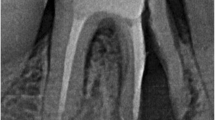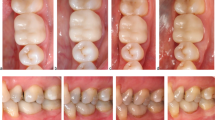Abstract
Objectives
The objective of this prospective clinical study was to evaluate the performance of chair-side generated crowns after 48 months.
Materials and methods
Forty-one posterior full contour crowns made of a machinable lithium disilicate ceramic (e.max CAD LT) were inserted in 34 patients applying a chair-side CAD/CAM technique. One crown per patient was randomly selected for evaluation at baseline, after 6, 12, 24, 36, and 48 months according to modified US Public Health Service criteria.
Results
After a mean observation time of 51 months (min, 48 months; max, 56 months; SD ± 2.3 months), 29 crowns were available for re-examination. Within the observation period, one failure occurred due to a crown fracture after 2.8 years. Four abutment teeth revealed signs of biological complications: Two abutment changed sensibility perception from positive to negative within the first 13 month. Two abutment teeth showed secondary caries below the crown margin, one after the 24, and another after the 48 month recall. Both abutments received cervical adhesive composite fillings. The failure-free rate was 96.3 % after 4 years according to Kaplan–Meier (CI: upper bound, 4.4 years; lower bound, 4.7 years).
Conclusions
Due to the fact that the secondary caries was not caused as a result of an inaccuracy of the crown margins and the endodontic complications were in a normal range, the clinical performance of the crowns was completely satisfying.
Clinical relevance
The chair-side application of lithium disilicate crowns can be recommended.



Similar content being viewed by others

References
Della Bona A, Kelly JR (2008) The clinical success of all-ceramic restorations. J Am Dent Assoc 139(Suppl):8S–13S
Marquardt P, Strub JR (2006) Survival rates of IPS empress 2 all-ceramic crowns and fixed partial dentures: results of a 5-year prospective clinical study. Quintessence Int 37(4):253–259
Etman MK, Woolford MJ (2010) Three-year clinical evaluation of two ceramic crown systems: a preliminary study. J Prosthet Dent 103(2):80–90. doi:10.1016/S0022-3913(10)60010-8
Giordano R (2006) Materials for chairside CAD/CAM-produced restorations. J Am Dent Assoc 137(Suppl):14S–21S
Holand W, Schweiger M, Frank M, Rheinberger V (2000) A comparison of the microstructure and properties of the IPS Empress 2 and the IPS Empress glass-ceramics. J Biomed Mater Res 53(4):297–303
Wiedhahn K (2007) From blue to white: new high-strength material for Cerec–IPS e.max CAD LT. Int J Comput Dent 10(1):79–91
Hickel R, Roulet JF, Bayne S, Heintze SD, Mjor IA, Peters M, Rousson V, Randall R, Schmalz G, Tyas M, Vanherle G (2007) Recommendations for conducting controlled clinical studies of dental restorative materials. Clin Oral Investig 11(1):5–33. doi:10.1007/s00784-006-0095-7
Kramer N, Ebert J, Petschelt A, Frankenberger R (2006) Ceramic inlays bonded with two adhesives after 4 years. Dent Mater 22(1):13–21
Fasbinder DJ, Dennison JB, Heys D, Neiva G (2010) A clinical evaluation of chairside lithium disilicate CAD/CAM crowns: a two-year report. J Am Dent Assoc 141(Suppl 2):10S–14S
Sailer I, Feher A, Filser F, Gauckler LJ, Luthy H, Hammerle CH (2007) Five-year clinical results of zirconia frameworks for posterior fixed partial dentures. Int J Prosthodont 20(4):383–388
Reich S, Uhlen S, Gozdowski S, Lohbauer U (2011) Measurement of cement thickness under lithium disilicate crowns using an impression material technique. Clin Oral Investig 15:521–526. doi:10.1007/s00784-010-0414-x
Reich S, Fischer S, Sobotta B, Klapper HU, Gozdowski S (2010) A preliminary study on the short-term efficacy of chairside computer-aided design/computer-assisted manufacturing-generated posterior lithium disilicate crowns. Int J Prosthodont 23(3):214–216
Pjetursson BE, Sailer I, Zwahlen M, Hammerle CH (2007) A systematic review of the survival and complication rates of all-ceramic and metal-ceramic reconstructions after an observation period of at least 3 years. Part I: single crowns. Clin Oral Implants Res 18(Suppl 3):73–85
Acknowledgments
The study was supported by Vivadent-Ivoclar.
Conflict of interest
The author SR has held oral presentations receiving a separate and appropriate honorarium, and he has held courses that were supported by Vivadent-Ivoclar with material.
Author information
Authors and Affiliations
Corresponding author
Rights and permissions
About this article
Cite this article
Reich, S., Schierz, O. Chair-side generated posterior lithium disilicate crowns after 4 years. Clin Oral Invest 17, 1765–1772 (2013). https://doi.org/10.1007/s00784-012-0868-0
Received:
Accepted:
Published:
Issue Date:
DOI: https://doi.org/10.1007/s00784-012-0868-0



